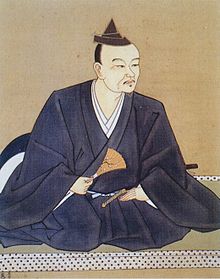Hōjō Ujitsuna
Hōjō Ujitsuna ( Japanese 北 条 氏 綱 ; * 1487 ; † August 10, 1541 ) was the son of Hōjō Sōun , the founder of the later Hōjō clan . He continued his father's efforts to conquer the Kantō region.
In 1524 he took Edo Castle , previously held by Uesugi Tomooki , starting a long rivalry with the Uesugi . Two years later, the Uesugi attacked Kamakura and burned it down. This was a significant symbolic loss for the later Hōjō, as they derived their name from the Hōjō , who perished after the defeat at the Siege of Kamakura (1333) .
The Uesugi attacked again in 1535 when Ujitsuna was absent to argue with the Takeda ; however, he managed to return and defeat Uesugi Tomooki and claim his land holdings. When Uesugi Tomoki died two years later, Ujitsuna took the opportunity to siege Kawagoe (1537) to secure his control over the Kantō region.
He then won the Battle of Kōnodai in 1538 , thus securing the Shimousa province for the Hōjō. In the years that followed, until his death in 1541, he focused on rebuilding Kamakura to make it a symbol of the growing power of the Hōjō, primarily through the rebuilding and expansion of Odawara Castle and Edo Castle. As head of the Hōjō and lord of Odawara, his son Hōjō Ujiyasu followed him .
swell
- Stephen Turnbull: Was in Japan: 1467-1615 . Osprey Publishing, Oxford 2002.
- Samurai Archives
| personal data | |
|---|---|
| SURNAME | Hōjō, Ujitsuna |
| ALTERNATIVE NAMES | 北 条 氏 綱 (Japanese) |
| BRIEF DESCRIPTION | Japanese general |
| DATE OF BIRTH | 1487 |
| DATE OF DEATH | August 10, 1541 |
